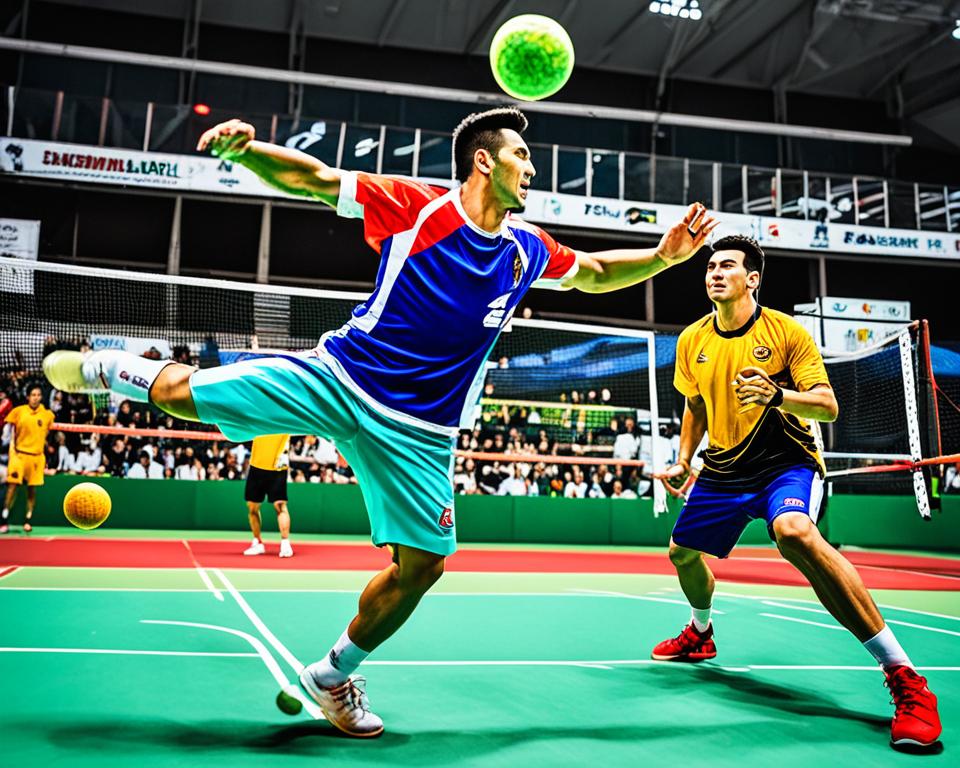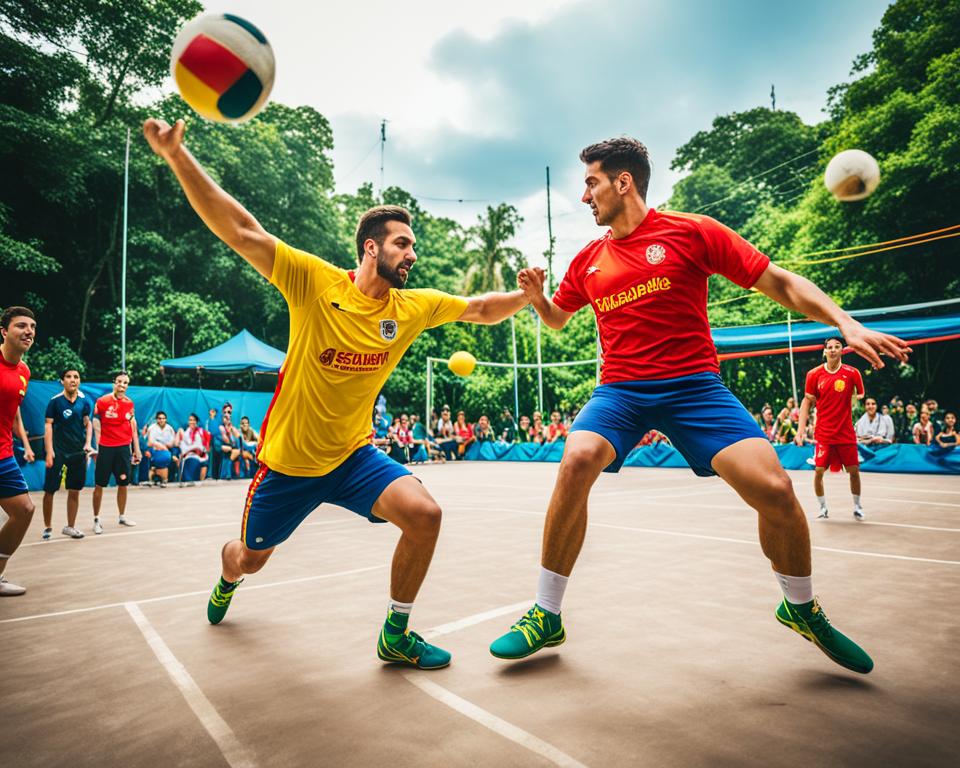Discover the Rich History of Sepak Takraw, the Ultimate Kick Game

Sepak takraw is a unique team sport. Teams of two to four players face off on a court. This court looks like a badminton court.1 You might call it a mix of volleyball and soccer. But here, they only use their feet, knees, shoulders, chest, and head to hit the ball.
The modern sepak takraw we know today began in 1960. In a meeting in Kuala Lumpur, officials from Malaysia, Singapore, Thailand, and Myanmar came together. They agreed on a name and set of rules. This marked the start of the game’s standardization.
Read more interesting information at ::googrekas
Introduction to Sepak Takraw
Sepak takraw is a sport from Southeast Asia that’s been played for centuries. It mixes quick movements, precise skills, and cultural traditions. Players work in teams of two to four. They can use their feet, knees, chest, and even their head to hit a ball up. The goal is to not let the ball touch the ground.
A Centuries-Old Southeast Asian Sport
In Malaysia, Sepak Takraw is a big deal and is known as the country’s national game. It’s similar to many other traditional games across Southeast Asia, like Sepak Raga and Takraw. These games have deep roots in the region’s history. The word “sepak” means “kick” in Malay, and “takraw” comes from Thai, meaning “muzzle” or “woven rattan ball.”
Blending Agility, Skill, and Cultural Heritage
Today’s Sepak Takraw takes bits from different sports like Soccer, Volleyball, and Gymnastics. It has grown a lot since being just a fun way to be active in the 1940s. Now, it’s a popular competitive sport that highlights the area’s culture.
Origins and Early History
The beginning of sepak takraw goes way back to ancient times in Southeast Asia. The Chinese are thought to have brought the game. They took inspiration from Cuju, a old game that soldiers played with a feather-filled leather ball. They kicked it around to keep it in the air.
Sepak Takraw’s Roots in Ancient Civilizations
Sepak takraw started more than 600 years ago, in the 15th century. Back then, the Sultanate of Malacca was the place to be. It grew from games that were already popular across Southeast Asia. Countries like Brunei, Indonesia, Malaysia, Singapore, and others had similar games.
The Malay Annals: Insights into the Game’s Past
The Malay Annals are a key source of early sepak takraw history. They tell us the game was loved and played widely back in the 15th century. It shows how important the game was to the culture of that time.
Sepak Takraw in the Malacca Sultanate
The Sultanate of Malacca was a big deal in the 15th and 16th centuries, ruling part of Southeast Asia. It was likely a major hub for sepak takraw‘s growth. During this time, the game became really popular. This laid the groundwork for its spread.
Sepak Takraw in Different Regions
Sepak takraw has a long history in Southeast Asia. Every area has added its own twist to the game. In Brunei, Malaysia, and Singapore, they call it sepak raga. Meanwhile, Thailand knows it as takraw. Indonesia, on the other hand, refers to it as rago or sepak takraw.
Sepak Raga in Brunei, Malaysia, and Singapore
Across Brunei, Malaysia, and Singapore, sepak raga is a popular variant. It holds similarities with the main sepak takraw game. But, it also has its specific rules and ways of playing in these countries.
Takraw in Thailand
Takraw is its name in Thailand. This version has a deep history. It began to take its current form in the early 1740s. Since then, it has become a national favorite. Thailand even hosts big events like the King’s Cup World Championships.
Rago in Indonesia
Indonesia has its unique game called rago or sepak takraw. It’s a bit like the main game but with its own playing styles. Within Indonesia, there are various ways they play the game.
These different versions of sepak takraw show its wide cultural roots. Each area brings something special to the game. With unique names, rules, and ways of playing, it’s clear how much the sport means across Southeast Asia.
Sepak Takraw’s Evolution and Modernization
At first, sepak takraw was just a fun game. It focused on keeping people active and helping them get better at moving. People played it to stretch and stay agile after long times of being still. But in the 1940s, a major change came. A net was added, and the game got more structured rules. This led to the start of the more recognizable sepak takraw we know today.
From Casual Play to Competitive Sport
In the mid-20th century, something big happened to sepak takraw. It became a serious competition. This shift started in Southeast Asia. People saw the game as something that could bring players and fans together.1 So, they made rules to make it fair for everyone. This was the step that turned sepak takraw into a sport loved worldwide.
The Introduction of Rules and Regulations
In 1960, friends from Malaysia, Singapore, Thailand, and Myanmar met up. They came to an agreement in Kuala Lumpur. This agreement was about the game’s name and its rules. Their work set the stage for sepak takraw to grow as a global sport. Thanks to their effort, the game’s popularity soared both locally and around the world.
| Key Milestones in Sepak Takraw’s Evolution | Year |
|---|---|
| The modern version of Sepak Takraw was introduced and standardized | 1960 |
| Sepak Takraw was first exhibited in Penang | 1945 |
| Sepak Takraw was introduced as a medal event in the Southeast Asian Games | 1965 |
| The International Sepaktakraw Federation (ISTAF) was formed | 1988 |
The Birth of the Modern Sepak Takraw
The modern sepak takraw began in Penang, Malaysia, in the mid-20th century. In 1945, Hamid Mydin and local athletes introduced “sepak raga jaring,” a new way to play. It turned the game from fun into a serious sport.
That year, three teams from areas with lots of Malays in Penang played for the Nyak Din Nyak Sham Trophy.
Hamid Mydin’s Contributions
Hamid Mydin was vital to making modern sepak takraw. He helped set the rules and added a net, making the sport more organized and competitive. In Penang, his work set the stage for the sport to become popular in and out of Malaysia.
sepak takraw history
Sepak takraw has a history dating back centuries to the Malacca Sultanate in the 15th century. Over time, the game has changed, moving from being just a fun activity to a popular sport.
Tracing the Game’s Global Expansion
The modern form of sepak takraw started in the 1940s. The first big Sepak Takraw competition was in Penang, Malaysia, on May 16, 1945. Since then, it has grown in popularity worldwide. It’s loved for its mix of sport, culture, and different styles in different places.

In 1960, the rules for Sepak Takraw were set in Kuala Lumpur by experts from Malaysia, Singapore, Thailand, and Myanmar. This was an important step in making the sport known around the world. Then, in 1988, the International Sepaktakraw Federation (ISTAF) was formed. ISTAF helps the sport grow more and more.
Now, sepak takraw can be played outdoors, indoors, or on the beach. Each team has two to four players. They can hit the ball with their feet, knees, shoulders, chest, and head. The game is key to the culture of Southeast Asia. There are similar games across the region, like Cuju, Chinlone, and Sipa.
Today, sepak takraw is loved all over. Its history shows how it has brought people together from different places. It’s a wonderful mix of sport and culture from Southeast Asia.
Sepak Takraw Tournaments and Competitions
The first competitive sepak takraw event was in Penang, Malaysia, on May 16, 1945. It marked a shift from playing for fun to playing to win. Three teams from different areas in Penang played for the Nyak Din Nyak Sham Trophy.
Inclusion in the Southeast Asian Games
Sepak Takraw became an official game at the 1965 Southeast Asian Peninsular (SEAP) Games in Malaysia. This happened after talks between Malaysia, Singapore, Laos, and Thailand. It was a big step showing more countries accepted the sport.
International Governing Bodies and Major Events
In 1965, the Asian Sepaktakraw Federation (ASTAF) was created to manage the game in Asia. And the International Sepaktakraw Federation (ISTAF) started in 1992 as the world’s main sepak takraw authority. They have a key role in big events like the King’s Cup Sepaktakraw World Championships. In 1997, these championships added matches for women.
In 1998, Circle Sepak Takraw was a part of the Asian Games. And in the same year, it was a show sport at the Commonwealth Games in Kuala Lumpur.
Cultural Significance and Legacy
Sepak takraw is more than just a game in Southeast Asia. It has a long history and is important in the region’s culture. The game started in Malaysia about 500 years ago. Back then, it was mainly for the royal court. Now, it is a vital and beloved part of the area’s traditions and identity.
Sepak Takraw as a Heritage Sport
Sepak takraw is a vital part of Southeast Asian traditions. It highlights the region’s skill, spirit, and culture. Being part of the Asian Games since 1990 shows its importance and respect.
The Game’s Role in Southeast Asian Traditions
Sepak takraw means a lot in Southeast Asia. It’s not just a game but mirrors cultural values. The sport has stayed popular since the 16th century. Now, countries like Malaysia, Thailand, and the Philippines have strong sepak takraw scenes. This keeps the game a key part of Southeast Asia’s heritage.

Sepak Takraw’s Global Reach
Sepak takraw is no longer just a local sport. It’s loved around the world now. People are drawn to it for its sporty action, deep roots, and local twists. This mix has won over fans globally. Clubs for sepak takraw can be found in 31 countries. This shows how far its appeal has spread.
There are more teams and games now than before. The Sepak Takraw U.S. Open has over 30 teams playing, which is more than last year. In Japan, a national contest now has over 50 teams, up from only six in 1989. The Sepak Takraw Swiss Open hosted teams from Europe to Malaysia. This proves sepak takraw’s popularity everywhere.
Countries in Southeast Asia, like Thailand and Malaysia, often win big. But, others, including Burma, Indonesia, and even Germany, are getting better. They win in major competitions like the Asian Games and the King’s Cup. The USA team has also done well, helping sepak takraw grow in the U.S.
Sepak takraw started small and now it’s known worldwide. This shows its lasting attraction and power to draw people. It’s a mix of action, history, and global competition that will keep it popular.
Variants and Related Games
Sepak takraw isn’t alone in the world of sports. There are many games like it. They come from various places. One game, Cuju, from ancient China, might be a relative. It was a military drill. Soldiers kept a feathered shuttlecock in the air, using their feet, much like in sepak takraw.
Cuju: The Ancient Chinese Predecessor
Cuju dates back to the Han Dynasty, between 206 BC and 220 AD. It’s an ancient Chinese sport that uses the feet to keep a ball in the air. Players could also use their chest and head. This game helped with physical fitness and strategy. It probably inspired games like sepak takraw in Southeast Asia.
Chinlone in Myanmar
Myanmar has chinlone, a sibling to sepak takraw. Similar to a dance, it blends sport and culture. Teams don’t compete but cooperate. They keep a rattan ball from touching the ground, using feet and various parts of the body. This shows in Myanmar’s tradition and ceremonies.
Sipa in the Philippines
The Philippines plays sipa. It’s another form of the foot-ball sport. Players air-juggle a rattan or synthetic ball. The game has centuries of history. It has been a part of the Philippines long before it was colonized.
Cuju, chinlone, and sipa are just some sepak takraw-like games in Asia. They show how diverse, significant, and beloved this sport is in the region. Every game has its unique touch. Yet, all share a common love for the skillful art of using feet in play. These games enrich the story of ball sports in Asia over the ages.
The Rise of Sepak Takraw in Modern Times
Sepak takraw has been making a big comeback lately. It’s winning over people all around the globe. Its mix of sports skill, cultural roots, and local twists are grabbing attention.
Many are working to make sepak takraw known more widely. This includes groups that set rules and support it, news and sports shows, and the game being taught in schools everywhere.
Popularization and Media Coverage
The International Sepaktakraw Federation (ISTAF) has a big part in spreading sepak takraw. This group includes 50 countries like the US, Canada, and more. Right now, they are having games to get the sport known better.
ISTAF is also working to make sepak takraw an official sport by the Olympics. By getting on big media channels, like the Olympic Channel, they hope to get there one day.
Sepak Takraw’s Inclusion in School Curricula
Many schools are adding sepak takraw to their class schedules. Lee Pao Xiong has worked hard to set up gaming spots in Minnesota. It draws in people from different communities to enjoy the sport.
In the US, the Takraw Association is pushing the sport forward. They want to make a strong US team for big competitions. In Singapore, the national team practices a lot, showing how dedicated they are.9
Sepak takraw is getting more known due to its interesting history and the effort of its players and coaches. With schools joining in, the sport’s future looks bright. It’s gaining a special place in the world of sports, especially in Southeast Asia.






